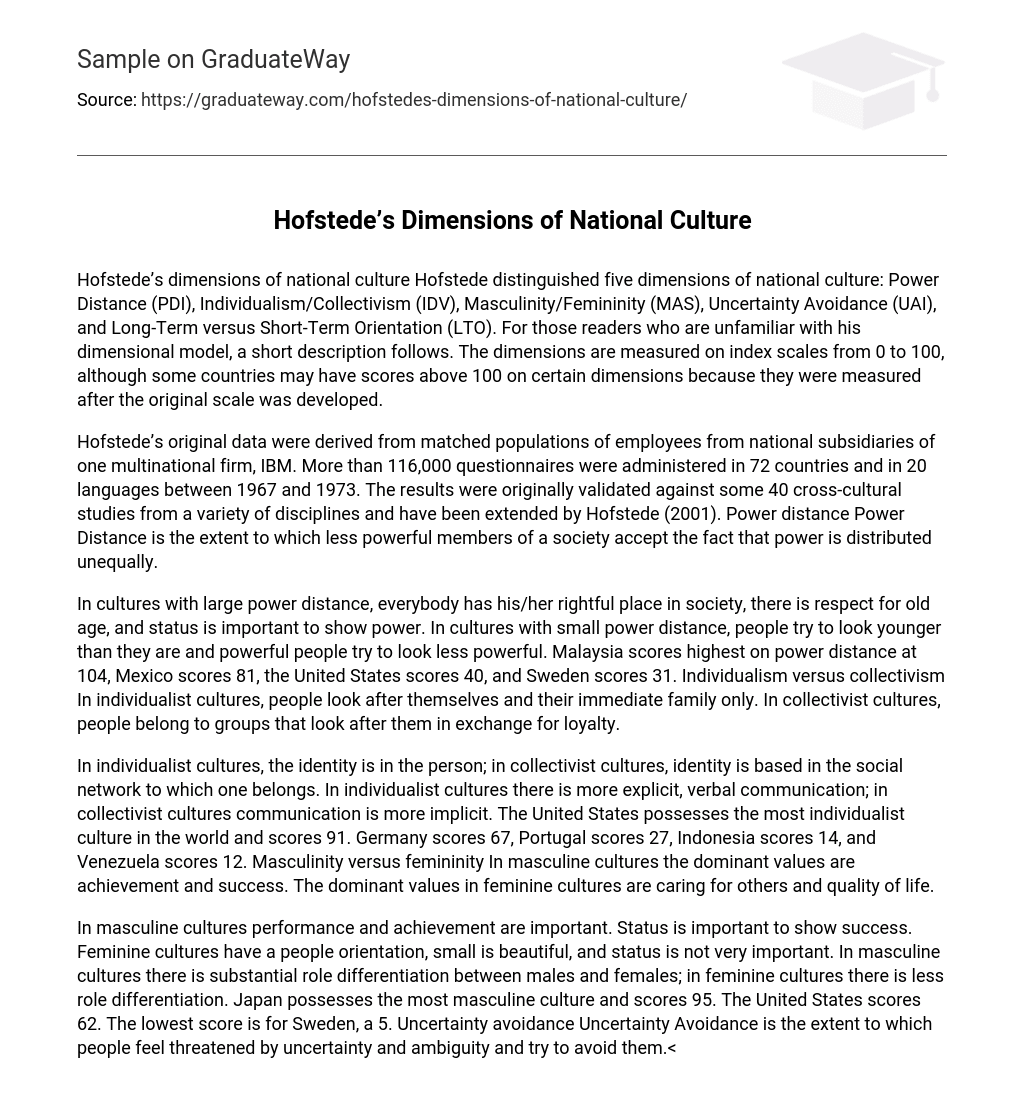Hofstede’s dimensions of national culture Hofstede distinguished five dimensions of national culture: Power Distance (PDI), Individualism/Collectivism (IDV), Masculinity/Femininity (MAS), Uncertainty Avoidance (UAI), and Long-Term versus Short-Term Orientation (LTO). For those readers who are unfamiliar with his dimensional model, a short description follows. The dimensions are measured on index scales from 0 to 100, although some countries may have scores above 100 on certain dimensions because they were measured after the original scale was developed.
Hofstede’s original data were derived from matched populations of employees from national subsidiaries of one multinational firm, IBM. More than 116,000 questionnaires were administered in 72 countries and in 20 languages between 1967 and 1973. The results were originally validated against some 40 cross-cultural studies from a variety of disciplines and have been extended by Hofstede (2001). Power distance Power Distance is the extent to which less powerful members of a society accept the fact that power is distributed unequally.
In cultures with large power distance, everybody has his/her rightful place in society, there is respect for old age, and status is important to show power. In cultures with small power distance, people try to look younger than they are and powerful people try to look less powerful. Malaysia scores highest on power distance at 104, Mexico scores 81, the United States scores 40, and Sweden scores 31. Individualism versus collectivism In individualist cultures, people look after themselves and their immediate family only. In collectivist cultures, people belong to groups that look after them in exchange for loyalty.
In individualist cultures, the identity is in the person; in collectivist cultures, identity is based in the social network to which one belongs. In individualist cultures there is more explicit, verbal communication; in collectivist cultures communication is more implicit. The United States possesses the most individualist culture in the world and scores 91. Germany scores 67, Portugal scores 27, Indonesia scores 14, and Venezuela scores 12. Masculinity versus femininity In masculine cultures the dominant values are achievement and success. The dominant values in feminine cultures are caring for others and quality of life.
In masculine cultures performance and achievement are important. Status is important to show success. Feminine cultures have a people orientation, small is beautiful, and status is not very important. In masculine cultures there is substantial role differentiation between males and females; in feminine cultures there is less role differentiation. Japan possesses the most masculine culture and scores 95. The United States scores 62. The lowest score is for Sweden, a 5. Uncertainty avoidance Uncertainty Avoidance is the extent to which people feel threatened by uncertainty and ambiguity and try to avoid them.
In cultures of strong uncertainty avoidance, there is a need for rules and formality to structure life and competence is a strong value resulting in belief in experts. In weak uncertainty avoidance cultures there is a strong belief in the generalist. Moreover, in weak uncertainty avoidance cultures, people tend to be more innovative and entrepreneurial. In cultures of strong uncertainty avoidance, people tend to be better groomed than in cultures of weak uncertainty avoidance because it is one way to face a threatening world.
Similarly, purity in food is an important need in cultures of high uncertainty avoidance. High uncertainty avoidance scores are observed for Greece with 112 and Mexico with 82. Low scores are observed for Denmark with 23 and the United Kingdom with 35. The United States scores 46. Long-term orientation versus short-term orientation Long-term orientation is the extent to which a society exhibits a pragmatic, future-oriented perspective rather than a conventional historic or short-term perspective.
Long-term oriented cultures are particularly found in East Asia and value acceptance of change, perseverance, thrift, and pursuit of peace of mind. Short-term orientation is found in the Western world. China has the highest long-term orientation score (118). Brazil scores 65 and the United Kingdom scores 25. The United States scores 29. Managerial implications In the new century with increased wealth, predicting and explaining consumer behavior differences across countries is indispensable for international retailers.
Expanding operations to countries with different cultural values than one’s own, without adapting to these differences, can lead to serious losses. This applies to the retail format used as well as to sourcing for different cultures. Acceptance of the Internet and any particular e-commerce varies across cultures. The varying success of e-commerce across countries can be predicted given knowledge of cultural differences. Cultural characteristics such as the degree of uncertainty avoidance and long-term orientation in particular would seem to be potentially useful when segmenting countries as to the potential of e-commerce.
If test markets are used for new products or new retail formats, managers must be aware that this does not automatically mean that other, culturally dissimilar countries will show the same effects. But countries can be grouped according to the type of cultural effect. For each product category, clusters can be formed of countries that are expected to have similar reactions. Hofstede’s model of national culture is a powerful instrument for international retailing strategy.





